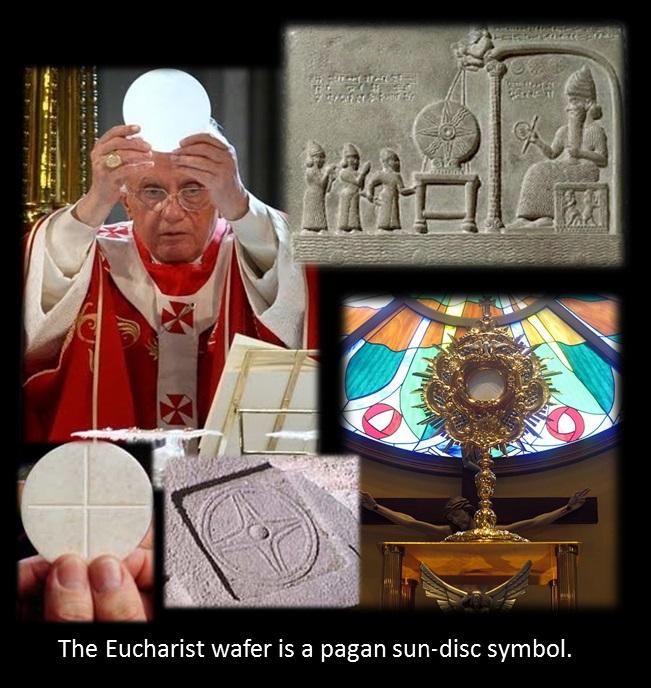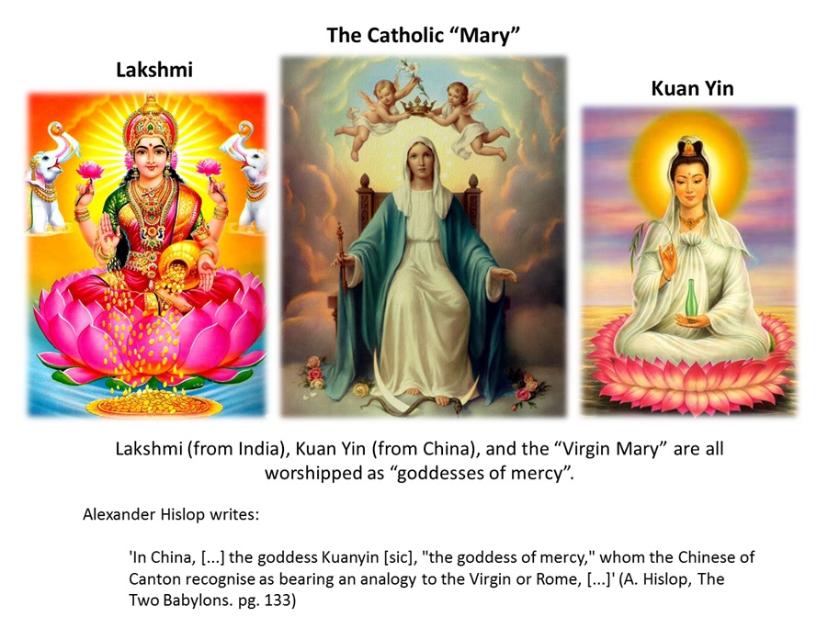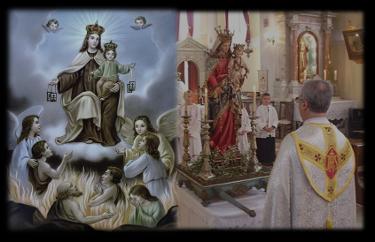Click to Read: ● Catholicism Exposed (Exposing Lies of the Catholic Church)
● Mystery Babylon (The Illuminati / Masonic / Catholic Connection)
● THE ORIGINS OF PURGATORY (AND EGYPT, GREECE, ETC.)
● Pagan Origins of the Mediatrix and the Eucharist
● EXPOSING CATHOLICISM'S LIES: PRAYING TO SAINTS
● Catholic Items Originating from Paganism
● Origins of the Rosary and the Sacred Heart
● Fire Worship and Catholicism
● Wax Candles and Fire Worship (Catholic Worship Exposed)
● Mormonism Exposed (The LDS Church Exposed)
● "Jehovah's Witnesses" Exposed (Watchtower Society Exposed)
Google Search (this website)
Google Translate (Translate this page.)

● WHAT IS THE ORIGIN OF THE EUCHARIST WAFER (or the unbloody sacrifice)?
(Click Here for More Info Exposing Catholicism)
Alexander Hislop, a historian from the 19th century wrote (bold / color added):
'The very shape of the unbloody sacrifice of Rome may indicate whence it came. It is a small thin, round wafer; and on its roundness the Church of Rome lays so much stress, [...] What could have induced the Papacy to insist so much on the "roundness" of its "unbloody sacrifice"? Clearly not any reference to the Divine institution of the Supper of our Lord; for in all the accounts that are given of it, no reference whatever is made to the form of the bread which our Lord took, when He blessed and break it, and gave it to His disciples, saying, "Take, eat; this is My body: this do in remembrance of Me."
[Note: Jesus taught that He is the Bread of life (the source of spiritual life), symbolized by the bread. Jesus did not teach that the bread transforms into Him inside someone's stomach. This transubstantiation is a teaching of ancient paganism (found in ancient Egypt and Babylon).]
[...]
The importance, however, which Rome attaches to the roundness of the wafer, must have a reason; and that reason will be found, if we look at the altars of Egypt. "The thin, round cake," says Wilkinson, "occurs on all altars." Almost every jot or tittle in the Egyptian worship had a symbolical meaning. The round disk, so frequent in the sacred emblems of Egypt, symbolised the sun. Now, when Osiris, the sun-divinity, became incarnate, and was born, it was not merely that he should give his life as a sacrifice for men, but that he might also be the life and nourishment of the souls of men [incarnate in the wafer].' (A. Hislop, The Two Babylons. pg. 134)

Nowhere in scripture is Mary (or any 'goddess') taught to be a mediatrix (or a female intercessor between God and man). Scripture is clear that there is only "one mediator between God and men, the man Christ Jesus" (1 Timothy 2:5).
1 Timothy 2 and Hebrews 7 say this about Jesus Christ, the one mediator…
1 Timothy 2:5-6 (bold added)
5 For there is one God, and one mediator between God and men, the man Christ Jesus;
6 Who gave himself a ransom for all, to be testified in due time.
Hebrews 7:25 (bold added)
25 Wherefore he is able also to save them to the uttermost that come unto God by him, seeing he ever liveth to make intercession for them.
● WHAT IS THE ORIGIN OF MARY THE "MEDIATRIX"? (or "co-mediator")
(Click Here for More Info Exposing Catholicism)
Alexander Hislop, a historian from the 19th century wrote:
'The Assyrian Venus, then--that is, the great goddess of Babylon--and the Cyprian Venus were one and the same, and consequently the "bloodless" altars of the Paphian goddess show the character of the worship peculiar to the Babylonian goddess, from whom she was derived. In this respect the goddess-queen of Chaldea [Semiramis or Ashtoreth, the "Queen of Heaven"] differed from her son, who was worshipped in her arms. [Pictures and statues in Catholic Churches show a "Queen of Heaven" holding her "son" in her arms.] He was, as we have seen, represented as delighting in blood. But she, as the mother of grace and mercy, as the celestial "Dove," as "the hope of the whole world," (BRYANT) was averse to blood, and was represented in a benign and gentle character. Accordingly, in Babylon she bore the name of Mylitta--that is, "The Mediatrix." *
* Mylitta is the same as Melitta, the feminine of Melitz, "a mediator," which in Chaldee becomes Melitt. Melitz is the word used in Job 33:23, 24: "If there be a messenger with him, an interpreter (Heb. Melitz, "a mediator"), one among a thousand, to show unto man his uprightness, then he is gracious unto him, and saith, Deliver him from going down to the pit; I have found a ransom."
Every one who reads the Bible, and sees how expressly it declares that, as there is only "one God," so there is only "one Mediator between God and man" (1 Tim 2:5), must marvel how it could ever have entered the mind of any one to bestow on Mary, as is done by the Church of Rome, the character of the "Mediatrix." But the character ascribed to the Babylonian goddess as Mylitta sufficiently accounts for this. In accordance with this character of Mediatrix, she was called Aphrodite--that is, "the wrath-subduer" *--who by her charms could soothe the breast of angry Jove, and soften the most rugged spirits of gods or mortal-men. In Athens she was called Amarusia (PAUSANIAS)--that is, "The Mother of gracious acceptance." **
* From Chaldee "aph," "wrath," and "radah," "to subdue"; "radite" is the feminine emphatic.
** From "Ama," "mother," and "Retza," "to accept graciously," which in the participle active is "Rutza." Pausanias expresses his perplexity as to the meaning of the name Amarusia as applied to Diana, saying, "Concerning which appellation I never could find any one able to give a satisfactory account." The sacred tongue plainly shows the meaning of it.
In Rome she was called "Bona Dea," "the good goddess," the mysteries of this goddess being celebrated by women with peculiar secrecy. In India the goddess Lakshmi, "the Mother of the Universe," the consort of Vishnu, is represented also as possessing the most gracious and genial disposition; and that disposition is indicated in the same way as in the case of the Babylonian goddess. "In the festivals of Lakshmi," says Coleman, "no sanguinary sacrifices are offered." In China, the great gods, on whom the final destinies of mankind depend, are held up to the popular mind as objects of dread; but the goddess Kuanyin [sic], "the goddess of mercy," whom the Chinese of Canton recognise as bearing an analogy to the Virgin or Rome, is described as looking with an eye of compassion on the guilty, and interposing to save miserable souls even from torments to which in the world of spirits they have been doomed. Therefore she is regarded with peculiar favour by the Chinese. This character of the goddess-mother has evidently radiated in all directions from Chaldea.' (A. Hislop, The Two Babylons. pg. 132-133) (bold / color / underline added)
__________________________________________
"She [Mary] is also mediatrix because she continues to intercede for us who are still working out our salvation on earth or suffering in purgatory." (The Question and Answer Catholic Catechism, p. 244, Q. 253.) (underline added)
'In China, [...] goddess Kuanyin, "the goddess of mercy," whom the Chinese of Canton recognise as bearing an analogy to the Virgin or Rome, is described as looking with an eye of compassion on the guilty, and interposing to save miserable souls even from torments to which in the world of spirits they have been doomed. Therefore she is regarded with peculiar favour by the Chinese.'(A. Hislop, The Two Babylons. pg. 132-133) (bold / underline / color added)
Nowhere in scripture is Mary taught to be a mediatrix (or female intercessor between God and man).
1 Timothy 2 and Hebrews 7 say this about Jesus Christ, the mediator…
1 Timothy 2:5-6 (bold added)
5 For there is one God, and one mediator between God and men, the man Christ Jesus;
6 Who gave himself a ransom for all, to be testified in due time.
Hebrews 7:25 (bold added)
25 Wherefore he is able also to save them to the uttermost that come unto God by him, seeing he ever liveth to make intercession for them.

The Doctrine of Purgatory was Taught in Ancient Greece, in Ancient Rome, and in Ancient Egypt.
(Click Here for More Info Exposing Catholicism)
Hislop writes about how the Greeks taught purgatory. He wrote (The Two Babylons, p.p. 139-140) (bold /color added):
In Greece the doctrine of a purgatory was inculcated [taught] by the very chief of the philosophers.
(READ MORE HERE: THE ORIGINS OF PURGATORY (AND EGYPT, GREECE, ETC.)
If You Would Like to Have a Relationship with the true God, Be an Adopted Child of God, and Go to Heaven…